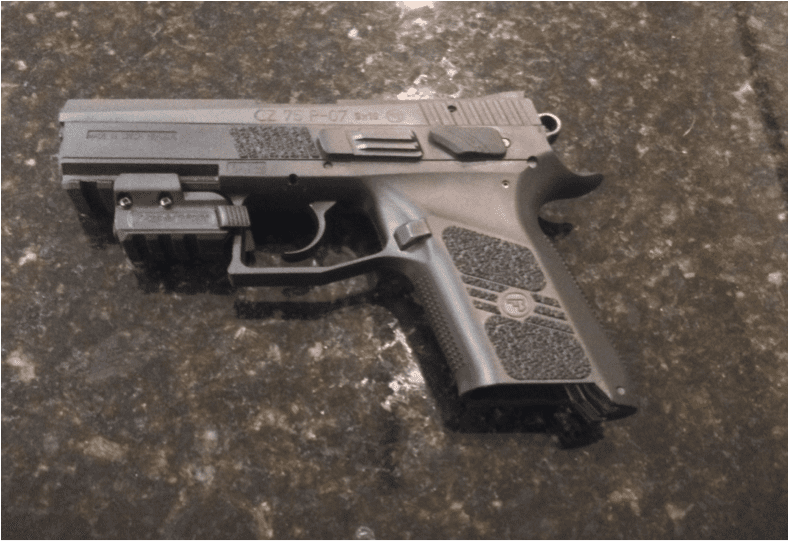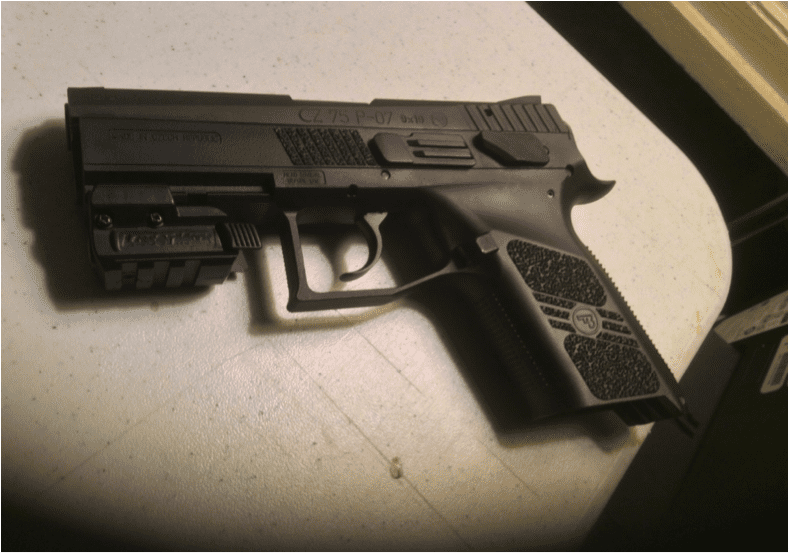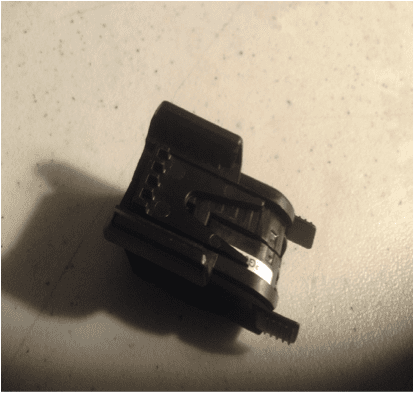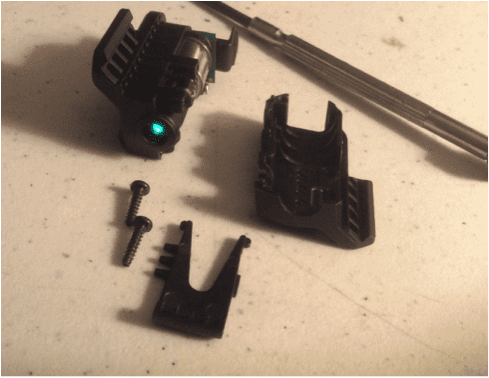
By Alan Mitchell
In the 30 plus years since the Governator demanded a “forty-five long slide vith lahsah sighting,” the cost, quality and demand for laser sighting systems has changed dramatically for the better. Ahhnolds prop took 10,000 watts to light the helium neon laser and encompassed a big battery, a switch, and long wire from under his jacket and sleeve, not very CCW friendly. Today, mass merchandisers, firearm specialty providers, and the internet offer everything from top-of-the-line LEO/military/competition level lasers to budget friendly devices for the general carrying public. The widespread availability of 1913 Rail system handguns has made the under dustcover laser an almost universally attachable accessory across a wide spectrum of pistols. So what can we get for under $150, and how many compromises are we making on what’s available at the bottom of the market? . . .

The LaserMax Spartan red and green rail-mounted lasers are advertised as “The First Perfect Fit for Handgun Rails” and retail for $149 (SPS-Green) and $99 (SPS-Red). Street prices are at least $10 less, however my SPS-G was $40 less, so it pays to shop around. Batteries (1/3N size) are $5.45 on the LaserMax site, I ordered two extra when I bought the laser and drop in a new one every six months.
Having found great value in a LaserMax Centerfire red mounted on the front of my Shield’s trigger guard, I was anxious to try a rail-mounted green laser that I could switch between my various range and carry pistols. Note: all pictures show an unloaded CZ P-07 Duty.
Riding on just a small part of a 1913 rail, the unique mounting system of the SPS-G allows for some customization of the reach to the activation paddles on both sides of the device. Here is the laser all the way back against the trigger guard . . .

and here it’s fairly far forward on the rail.

The mounting system utilizes a small insert that looks something like a boot jack in an old country store that both locks into the 1913 rail (the crenelated forward edge shown below) and with three small teeth (starboard side) that lock into the upper portion of the mount that wraps around the rail. The flexibility of the boot jack system allows for wide adjustability to custom fit specific firearms at user selectable distances between the front of the rail and the front of the trigger guard.
A minimum of 1” of rail is required to mount an SPS laser, so full and compact semi-automatics with rail should be fine. The LaserMax website does have a product selector to check your firearm’s specifications.


Most of the space within the small device is split between a rather large battery and a rather small laser module. The two halves screw together with two small Phillips head screws. Two immediate concerns are obvious. The entire module must be removed from the firearm to change the battery, and the screws are turning down into plastic; expect that they will become wobblier over time.
When properly installed, the laser fits tightly to the rail. If you feel any wobble you have probably not installed it correctly.


An included Allen wrench adjusts the lasers windage (on the right side shown above) and elevation (under the chin of the laser-see picture below). Running 500 rounds of a variety of ammunition has not altered the set point of the laser; it is still two inches elevation above the bore sight at 21 feet as I originally set the aim point.
The paddle switches are another area of concern for this device. Unlike the recessed buttons on either side of my Shield’s laser, the paddle actuators are easily tripped on and off when holstering, setting the firearm down on a shooting rest at the range, or accidentally brushing while putting your trigger finger into the guard. Originally I had the laser all the way back against the trigger guard, but moved it closer to the front of the dust shield to avoid some of the inadvertent switching. This works much better for me during range use.
On the positive side, the paddles are large and easy to reach with fingers from either your shooting or support hand while the recessed buttons on some lasers (like on my Shield) take a bit of feeling around or taking your eyes off target to look at the side of the laser to find the button. Having your trigger finger at the uniform cover mode (and on the nicely textured pad courtesy of CZ) is well aligned to tapping the laser to ‘on’.
Switch positions are: off, steady laser on, pulsing laser on. The operator can switch between steady and pulsing by holding down one of the paddles for five seconds while the laser is on. The laser will then switch on with that pattern every time after unless the operator selects the other pattern. The laser will switch off after 10 minutes of continuous use, and I can confirm this through testing. A fresh battery is expected to last 60 minutes in continuous use.

Do you know how hard it is to hold an iPad in one hand, an unloaded pistol in the other, and line up the sights and laser? Next time I will try an assistant…or a trick shooter who uses mirrors.
Green lasers are touted as being better than red for daylight use, and comparing my red and green units in daylight, I concur. Also the green light seems brighter in low light situation than red, so a win/win unless cost is the ultimate goal. Science tells us that a 5mW laser (all LaserMax products use this level) is the same brightness in any color, but green light’s shorter wavelength may appear brighter to the human eye.
Overall, the LaserMax SPS series are overall quite small and light. If you are holstering the firearm, you will have to do some serious searching for an appropriate rig. Some quick checks with holster manufacturers online shows some availability of appropriate holsters, but any laser is going to narrow your selections…choose appropriately!

What self-respecting rail-mount laser wouldn’t have its own rail to mount a light (or another laser)? The elevation adjustment can be seen at the front edge of the laser in the picture above.
With my less-than-stellar eyesight, a laser adds much to the enjoyment of range time, and confidence if ever having to fire without a complete sight picture or stable stance. Additionally, lasers are useful in training, showing quite brightly one’s unfortunate tendencies to pull/push/flinch when dry firing.
LaserMax has put together a very nice, small, accurate package for the money. Knowing some of the compromises made to stay in the popular priced strata, you can decide if it is the right package for your money.
SPECIFICATIONS:
Weight: Just over ½ oz.
Output: 5mW, the legal limit. red or green
MSRP: $149 (green), $99 (red) Retail $10-$40 less.
Warranty: 5-year limited
RATINGS (out of 5 Stars):
Accuracy: * * * * *
It’s held aim point through 500 rounds of various 9mm with no adjustments to windage or elevation.
Function: * * * * *
Like any good laser, you really don’t have to use your sights at short range. Very useful in training to see what you are doing to the aim point with bad habits before the sear drops the hammer/striker.
Ergonomics: * * *
No problem with the mounting, weight, or size of the laser, but the activation paddles are highly prone to inadvertent switching on or off. Easy to reach from the finger in the uniform cover mode) position along the frame.
Build Quality: * * * *
Just watch for wobbly mounting screws over time.
Overall: * * * *
Great value for the money. Accuracy, reliability, usefulness in a popularly priced laser.




For that price, no thanks. I will, however, take a phased plasma rifle in the 40 watt range.
‘Hey, just what you see pal!”
So what’ll it be?
All.
I may close early today.
(actually, he said “which’ll it be?”)
I remember seeing these movies many years ago before I had any experience with firearms and thinking to my naive self, ‘Wow that’s awesome stuff. You just put the dot of light on what you want to hit and that’s exactly where the bullet will go. No skill needed, no nothing, just use the light.’
Of course, that’s not how it works. It shows to me how easily inexperienced people are misled.
Hey I don’t care if your gun is loaded or not. It can’t hurt me through the screen.
Bullets can’t travel down a series of tubes!
I’ve always found lasers slower than sights. I’d rather train front sight on target instead of trying to find a dot that only realistically works in certain light conditions…
Deuteranomaly is a reduced sensitivity to green light and is the most common form of color blindness. I know because I have it. Green lights seem white, so I have no trouble driving, but matching my clothes has been a challenge over the years.
I see green laser light as white, which means it’s invisible to me in daylight. A red laser dot is more visible to me during daylight hours.
But red or green, I dislike laser sights and don’t use them. YMMV.
Man, seeing that picture brought tears to my eyes. I should never have sold my Hardballer. 🙁
That AMT was a neat gun…
To me the value is more intimidation factor than anything else. Bad guy sees red laser dot on his crotch he is less likely to want to proceed with the attack. Most don’t want to become a Tupac!
Maybe 10,000 volts, but definitely not 10,000 watts.
Came here looking for a review of Arnold’s laser sight. Was disappointed.
Comments are closed.